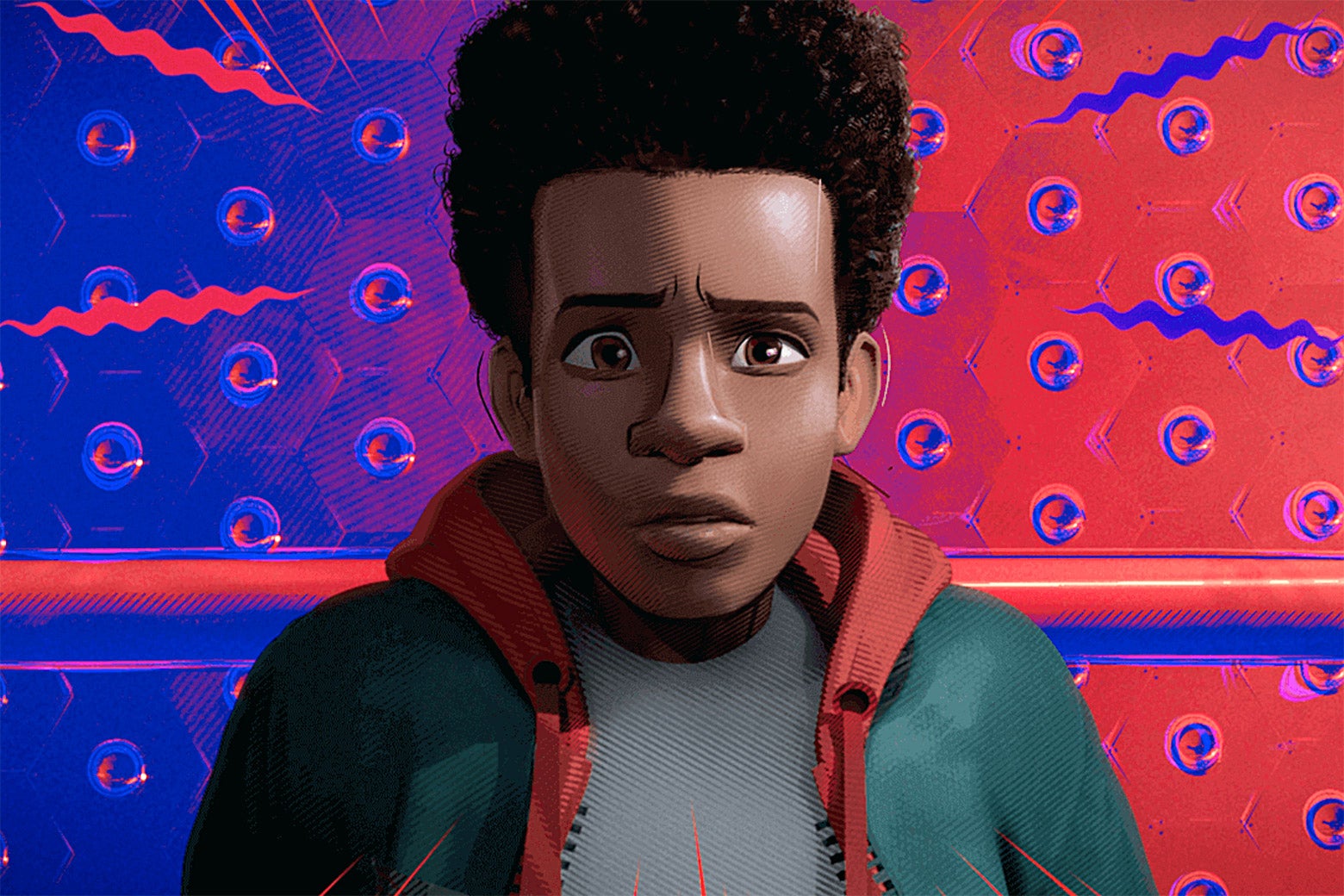The biggest problem with comic-book movies is that they only resemble certain kinds of comic books. Given the pressures on entries in what have grown to be decades-spanning multibillion-dollar cinematic universes, it’s understandable that their plots always hinge on preventing the end of (at least) the world: Even an ostensible buddy comedy like Thor: Ragnarok takes its cues from a mythological apocalypse. There’s precious little room in these high-stakes behemoths for the inventive detours and quirky one-offs that are as much a part of comic-book storytelling as tortured reinventions and universe-threatening villains. Movies can take on X-Men’s tragic Dark Phoenix arc (twice), but there’s no cinematic equivalent of, say, Animal Man’s “The Coyote Gospel,” which recasts Roadrunner cartoons as a bleak parable of life under the eye of an uncaring god.
In Spider-Man: Into the Spider-Verse, the fate of the world is still at stake—worlds, even. But the movie’s plot, which brings together alternate-universe versions of Marvel’s iconic web-slinger, ensures that none of them has to bear the burden alone. There’s the familiar Spider-Man, Peter Parker, who as far as the movies are concerned has thus far been the only one: Tobey Maguire, Andrew Garfield, and Tom Holland have all left their marks on the character, but they’ve all been coloring within the same lines. In Spider-Verse, Peter (voiced by Chris Pine) isn’t long for this particular world: Within minutes, he’s crushed by the Kingpin (Liev Schreiber), a hulking tycoon who doesn’t care about sundering the multiverse as long as it gives him a chance to bring back his dead wife and child. In Peter’s place rises Miles Morales (Shameik Moore), yet another in a long line of nerdy, awkward high school students who gains his powers from a radioactive spider’s bite. This Spider-Man, however, isn’t being raised by the familiar white-haired Aunt May and Uncle Ben: His parents are black and Latina, which makes him the movies’ first Spider-Person of Color and one of few nonwhite superheroes in an industry that is scrambling to emulate Black Panther’s record-breaking success.
The universe Miles inhabits isn’t quite our own—when he swings past a familiar-looking billboard with white script against a red background, it’s for a beverage called “Koka-Soda”—and the animation, directed by Bob Persichetti, Peter Ramsey, and Rodney Rothman, emphasizes a sense of otherworldliness. Instead of fleshy hyper-realism, the images have the texture of a comic-book page, and blocks of colors in the background slip off-register as if the movie were being projected off cheap newsprint. (It’s a neat effect, but it can be distracting, and it makes some scenes look as if you’re watching a 3-D movie without glasses.)
In the comics, Morales’ 2011 debut was an enormous cultural marker, but it was also cordoned off in a separate “Ultimate Universe” while the old Peter Parker lived on elsewhere. Miles was a Spider-Man, not the Spider-Man. That’s true of Spider-Verse as well, where he’s eventually joined by Gwen Stacy (Hailee Steinfeld), Peni Parker (Kimiko Glenn), and Peter Porker (John Mulaney), each their own universe’s versions of Spider-Man (or -Woman). “Anyone can wear the mask,” we’re told, be they a white woman, an Asian teenager, or um, a cartoon pig. There’s even another Peter Parker, this one voiced by Jake Johnson, a paunchy middle-aged variant whose spirit has been broken by his failed marriage.
The interactions between this second Peter—Peter B. Parker, to help keep things straight—and Miles are Into the Spider-Verse’s heart, and they double as a comment on the genre itself.
Peter’s been doing this forever, and he knows all the tricks of the trade, but he’s tired and flabby and he’s seen better days. Miles is young and green, barely able to master a web-shooter, but he’s got cool new abilities (even if he doesn’t quite know how to use them), and more importantly, he’s actually excited to be Spider-Man. Into the Spider-Verse is run through with that excitement, and its audiences will be, too.
After a solid decade of Marvel movies modeled on the same template, it’s a thrill to watch one that’s allowed to find its own rhythms, to play with form and content without contorting the plot to fit in a minor character who might become important five movies from now. And it’s amazing to live, at long last, in a world where everyone, at least in theory, can have a Spider-Man who looks like them, and those heroes can coexist without one needing to be eliminated to make room for the next. It’s telling that the movie’s Spider-convocation is a brief one, and that it stresses the necessity of each hero returning to the world from which they came. But if we don’t live in Miles Morales’ world, Into the Spider-Verse brings our own closer to it, and reminds us that great responsibility can also come with great fun.
